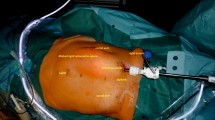Abstract
Background
In the VTEP series, some patients declared that their abdomen was “somewhat swollen”, and the authors suggested that this might be related to disruption of the posterior sheath due to the crossing. Following this observation, we decided to evaluate the systematic repair of the posterior sheath.
Methods
In 50 consecutive patients operated for ventral hernias, the VTEP procedure was modified, using the linear stapler to perform simultaneous division and closure of the posterior sheath. Perioperative data and short-term results were prospectively assessed.
Results
Six (12%) complications occurred: one hematoma, one sudden death at home five days after surgery in a man with history of cardiac disease, and 4 cases of dehiscence of the staple line, which were successively reoperated by suture of the gap and posterior sheath release incision (PSR). With a mean follow-up of 7.5 months (4–12) there were no recurrences and 2 cases of “swollen abdomen”, in patients who undergone PSR. The “swollen abdomen” did not occur when the posterior sheath was repaired without PSR. Preoperative diastasis bulging present in 11 cases, was totally or partially corrected in 8 and 1 cases, respectively, and unchanged in 2 cases.
Conclusion
The sVTEP procedure, can contribute to prevent the swollen abdomen and to diastasis correction. The PSR can prevent staple line disruption or permit tension-free repair of the dehiscence, but then, the newly created lateral gaps can finally entail the same drawback. Search for the best solution to treat the gap in the posterior sheath requires further studies.







Similar content being viewed by others
References
Reinpold W, Schroeder M, Berger C, Nehls J, Schroeder A, Hukauf M, Kockerling F, Bittner R (2018) Mini- or less-open sublay operation (MILOS): a new minimally invasive technique for the extraperitoneal mesh repair of incisional hernias. Ann Surg 269:748–755
Schwarz J, Reinpold W, Bittner R (2017) Endoscopic mini/less open sublay technique (EMILOS)-a new technique for ventral hernia repair. Langenbecks Arch Surg 402:173–180
Belyansky I, Daes J, Radu VG, Balasubramanian R, Zahiri HR, Weltz AS, Sibia US, Park A, Novitsky Y (2018) A novel approach using the enhanced-view totally extraperitoneal (eTEP) technique for laparoscopic retromuscular hernia repair. Surg Endosc 32:1525–1532
Ngo P, Cossa JP, Largenton C, Johanet H, Gueroult S, Pélissier E (2020) Ventral hernia repair by totally extraperitoneal approach (VTEP): technique description and feasibility study. Surg Endosc. https://doi.org/10.1007/s00464-020-07519-2
Li B, Qin C, Bittner R (2018) Totally endoscopic sublay (TES) repair for midline ventral hernia: surgical technique and preliminary results. Surg Endosc. https://doi.org/10.1007/s00464-018-6568-3
Muysoms F, Van Cleven S, Pletinckx P, Ballecer C, Ramaswamy A (2018) Robotic transabdominal retromuscular umbilical prosthetic hernia repair (TARUP): observational study on the operative time during the learning curve. Hernia 22:1101–1111
Bittner R, Schwarz J (2017) Endoscopic mini/less open sublay operation for treatment of primary and secondary ventral hernias of the abdominal wall. Eur Surg 49:65–70
Stoppa R (1996) The French operation in a major anterior incisional hernia. In: Skandalakis (ed) Modern Hernia repair. The Parthenon Publishing Group, New York, pp 23–44
Costa TN, Abdalla RZ, Santo MA, Tavares RRFM, Abdalla BMZ, Ceconnello I (2016) Transabdominal midline reconstruction by minimally invasive surgery: technique and results. Hernia 20:257–265
Moore AM, Anderson LN, Chen DC (2016) Laparoscopic stapled sublay repair with self-grip** mesh: a simplified technique for minimally invasive extraperitoneal ventral hernia repair. Surg Technol Int XXIX:131–139
Carbonell AM (2008) Interparietal hernias after open retromuscular hernia repair. Hernia 12:663–666
Robin-Lersundi A, Hernando LB, López-Monclús J, Cruz Cidoncha A, San Miguel Méndez C, Jimenez Cubedo E, García-Ureña MA (2018) How we do it: down to up posterior components separation. Langenbecks Arch Surg 403:539–546
Novitsky YW, Elliott HL, Orenstein SB, Rosen MJ (2012) Transversus abdominis muscle release: a novel approach to posterior component separation during complex abdominal wall reconstruction. Am J Surg 204:709–716
Gibreel W, Sarri MG, Rosen M, Novitsky Y (2016) Technical considerations in performing posterior component separation with transverse abdominis muscle release. Hernia 20:449–459
Belyansky I, Zahiri HR, Park A (2016) Laparoscopic transversus abdominis release, a novel minimally invasive approach to complex abdominal wall reconstruction. Surg Innov 23:134–141
Funding
No funding was received for this work.
Author information
Authors and Affiliations
Corresponding author
Ethics declarations
Disclosures
Drs Jean-Pierre Cossa, Philippe Ngo and Édouard Pélissier have no conflicts of interest or financial ties to disclose.
Additional information
Publisher's Note
Springer Nature remains neutral with regard to jurisdictional claims in published maps and institutional affiliations.
Rights and permissions
About this article
Cite this article
Cossa, JP., Ngo, P. & Pélissier, É. Stapled VTEP (sVTEP), diastasis and the “swollen abdomen”. Surg Endosc 36, 3382–3388 (2022). https://doi.org/10.1007/s00464-021-08656-y
Received:
Accepted:
Published:
Issue Date:
DOI: https://doi.org/10.1007/s00464-021-08656-y




